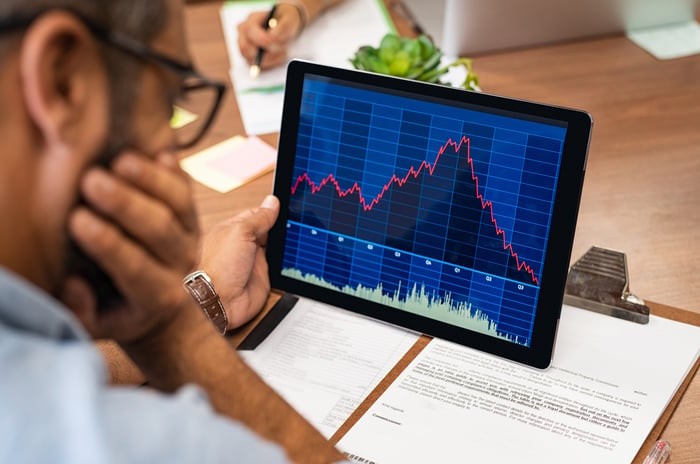Although you probably don't need the reminder, it's been an awful year for Wall Street.
A four-decade high for inflation, weakening economic growth, a historically hawkish Federal Reserve, and persistent global supply chain issues have combined to push the iconic Dow Jones Industrial Average (^DJI 0.77%), broad-based S&P 500 (^GSPC 0.83%), and growth-driven Nasdaq Composite (^IXIC 1.02%), firmly into bear market territory. As of early last week, the Dow, S&P 500, and Nasdaq had respectively shed as much as 20%, 24%, and 34% from their closing highs.

Image source: Getty Images.
There's little question that the velocity and unpredictability of downside moves during bear markets can tug at the heartstrings of investors and entice rash decision-making. Yet it's equally important to recognize that bear markets offer incredible opportunity to those who are patient.
Nevertheless, the prevailing question on the minds of tenured and new investors is the same: Where will the bear market find a bottom?
This indicator portends serious downside to come for the major indexes
According to two valuation-based indicators -- the S&P Shiller price-to-earnings (P/E) ratio and the S&P 500's forward P/E ratio -- the worst may be in the rearview mirror. Using data from previous bear markets, these valuation-based metrics suggest the benchmark S&P 500 could hit its trough in the 2,939 to 3,337 range.
But this is something of a best-case scenario that assumes minimal deterioration in the earnings of S&P 500 companies. There are other indicators that portend a much steeper decline may be coming, with the most bearish of them being outstanding margin debt.
Margin debt is the amount of money borrowed by investors from a brokerage, with interest, to purchase or short-sell securities. Over long periods, it's perfectly normal for the amount of outstanding margin debt to increase in step with the overall value of the equity markets. However, in the few instances where outstanding margin debt skyrocketed in a short time frame (i.e., risk-taking significantly increased), bad things followed.
FINRA Margin Debt data by YCharts.
Since the beginning of 1995, there have been only three instances where outstanding margin debt increased by at least 60% on a trailing-12-month basis:
- March 1999 through March 2000, which immediately preceded the beginning of the dot-com bubble bursting. The S&P 500 went on to lose 49% of its value at its peak.
- June 2006 through June 2007, which was just months prior to the financial crisis taking shape. The S&P 500 eventually lost 57% of its value.
- March 2020 through March 2021, which was less than a year before the stock market peaked. As noted, the S&P 500 has lost close to a quarter of its value thus far.
While we're not dealing with a lot of data points here, the clear takeaway has been that skyrocketing margin debt leads to a roughly 50% eventual decline in the S&P 500.
If this historical data were to prove accurate once again, the S&P 500 would be unlikely to find a bottom until closer to 2,457 on the high side and 2,072 on the low end. What's worth noting is that the coronavirus bear market bottom in 2020 of 2,192 fits comfortably within this range and provides a psychological floor for the most bearish of investors.

Image source: Getty Images.
The one investment strategy to rule them all
Though having margin debt portend significant downside in the Dow, S&P 500, and Nasdaq might sound depressing, keep in mind that no indicator has a perfect track record of predicting where bear markets will bottom. If there was a foolproof bear market indicator, you can be sure every Wall Street professional would be using it by now.
There is, however, an investment strategy that has proved unstoppable for more than a century.
Every year, market analytics company Crestmont Research releases data it compiles on the rolling 20-year total returns, including dividends paid, of the S&P 500. In total, Crestmont has published the rolling 20-year total returns, expressed as an average annual total return, for 103 end years (1919 through 2021). For example, the rolling 20-year total return for the end year of 1992 would include years 1973 through 1992, expressed as an average annual total return.
What Crestmont's data continues to show is that buying and holding an S&P 500 tracking index for 20 years has been automatic for more than a century in the return department. Not only did investors who held for at least 20 years make money 103 out of 103 times, but patience made some folks a lot richer. Approximately 40% of these 103 end years produced average annual total returns of 10.9% to 17.1%. This level of return can double your money every 4.2 years to 6.6 years.
What this data clearly shows is that when you put your money to work in the stock market matters far less than how long you plan to hold onto your positions. It also implies that buying an exchange-traded fund (ETF) that mirrors the movements of the S&P 500, Nasdaq Composite, and/or Dow Jones Industrial Average, would be a genius move for long-term investors with these indexes well off their respective highs.





